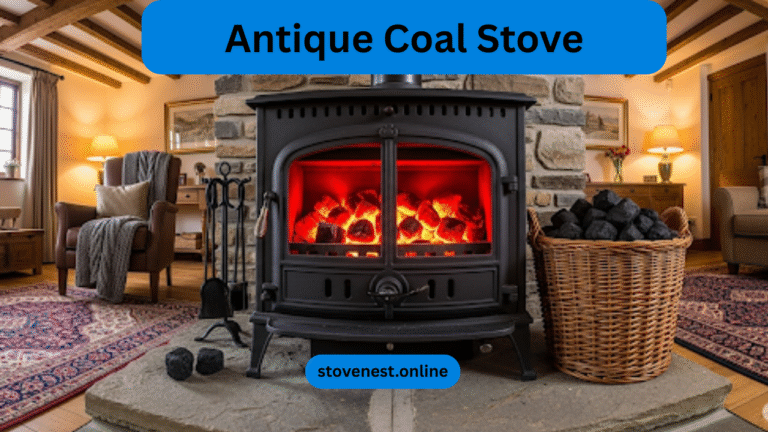Coal Burning Stoves
Coal Burning Stoves have been a popular heating solution for centuries, providing consistent warmth even in the harshest winter months. While these stoves have evolved with technology, the basic principle of using coal as a fuel source remains the same.
What Is a Coal Burning Stove?
A coal burning stove is a heating device that uses coal as its primary fuel source to produce heat. These stoves are often made from cast iron or steel and are designed to provide efficient, long-lasting warmth. They can be used for both heating a single room or, in larger models, to heat an entire home.
Coal burning stoves are most commonly found in rural areas where coal is abundant and more affordable than other heating sources.
When it comes to coal stove, an antique coal stove is a precious heating appliance for homeowners.
How Do Coal Burning Stoves Work?
Coal stoves work through the process of combustion. When coal is ignited, it burns to produce heat, and the resulting hot gases and ash are vented out of the stove through a chimney or flue. Many modern coal stoves are designed with advanced air-tight systems to control the burn rate, offering more efficiency and better heat retention.
Benefits of Using Coal Burning Stoves
- Efficiency:
Coal burns hotter and longer than wood, making it a more efficient option for heating. - Cost-Effective:
Coal is often less expensive than other fuel options, making it a budget-friendly solution for long-term heating. - Sustainability:
Coal is a reliable and long-lasting fuel, providing consistent heat even in harsh winters. - Eco-Friendly Options:
Newer models are designed to reduce emissions and improve environmental impact.
As we are discussing about those stoves that are EPA certified you may check:
Drolet Wood Stoves: EPA-Certified Heating & Efficiency
Types of Coal Stoves
There are a few different types of coal burning stoves, each with its unique benefits and considerations:
Small Coal Stove
A small coal stove is ideal for heating smaller spaces. These compact models are easy to install and operate, offering the same efficient heating as larger units but with less fuel consumption. Small coal stoves are perfect for cabins, small homes, or as a supplementary heat source in a larger home.
Wood and Coal Burning Stove
If you’re someone who enjoys versatility, a wood and coal burning stove might be the solution for you. This type of stove allows you to burn both wood and coal, giving you flexibility in your choice of fuel. These stoves are ideal for those who want to take advantage of readily available wood but also want the efficiency of coal when the temperature drops.

Can You Burn Wood in a Coal Stove?
A common question among homeowners is, can you burn wood in a coal stove? The answer depends on the stove’s design. Some coal stoves are equipped with a dual-fuel system that allows for burning wood and coal, while others are specifically designed for coal use.
It’s important to check the manufacturer’s instructions before attempting to burn wood in a coal stove, as burning the wrong fuel can damage the stove or even create dangerous situations.
Safety Considerations for Burning Wood in a Coal Stove
If your coal stove is not designed for dual fuel use, it’s best to avoid burning wood in it. Coal stoves are built with air-tight seals that are ideal for coal, which burns hotter than wood. Burning wood in a non-dual fuel stove can lead to incomplete combustion, creosote buildup in the chimney, and other safety concerns.
Read also: Antique Fireplace Insert.
How to Use and Maintain a Coal Burning Stove
Using a coal stove effectively requires understanding how to manage the fuel and maintain the stove properly.

Proper Fueling
To achieve the best performance from your coal stove, it’s important to use the right type of coal. Anthracite coal is the most commonly used type due to its high carbon content and low moisture. It burns hotter and longer, making it ideal for home heating. Be sure to store your coal properly to prevent moisture absorption, which can make it difficult to ignite.
Cleaning and Maintenance
Regular maintenance is crucial for extending the life of your coal stove. Clean the ash pan frequently to maintain airflow and prevent a buildup of ash that could clog the system. Additionally, check the stove’s venting system and chimney regularly to ensure that soot or creosote doesn’t accumulate.
Here are some quick maintenance tips:
- Clean the stove regularly:
Vacuum out ashes and check for any blockages. - Inspect the chimney:
A clean chimney ensures proper ventilation and reduces fire risk. - Check seals:
Ensure the stove door seals are intact to maintain combustion efficiency.
If you have easy access to anthracite coal and value a steady, low-maintenance heat output, it’s certainly an option worth exploring. For more information on efficient and clean-burning appliances, you can always visit the Stoves Nest website.

